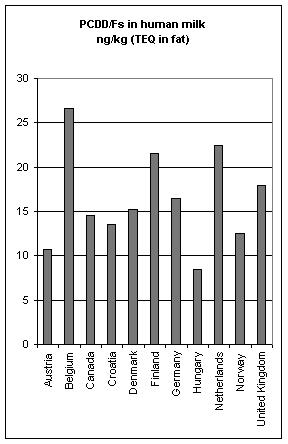Body burden: Difference between revisions
(New page: {{encyclopedia|moderator=Henrik}} body burden, the total amount of a chemical in the body. Average body burden of total sum of PCBs in industrialised countries range from less than 10 mg...) |
No edit summary |
||
| (3 intermediate revisions by 3 users not shown) | |||
| Line 1: | Line 1: | ||
{{encyclopedia|moderator=Henrik}} | {{encyclopedia|moderator=Henrik}} | ||
'''Body burden''': the total amount of a chemical in the body. Average body burden of total sum of PCBs in industrialised countries range from less than 10 mg to 50 mg (ΣPCB) per person (less than 1 to 5 mg/kg [ΣPCB in fat]). Average daily intake of the sum of PCBs is 0.2 µg/kg b.w. or 14 µg per person. Average body burden of dioxins in young western European population is 100-200 ng (TEq) per person (0.000,000,1 - 0.000,000,2 g [TEq]); it can also be expressed as 10-20 ng/kg (TEq in fat) (Figure 2), in 60-year-old population 500-1000 ng (TEq per person). In steady state (see this) the body burden is about 5000 times the daily intake of dioxins. Average daily intake in many countries (see also [[PCDD/F]] - sources) is 1 to 2 pg I-TEq/kg b.w. or about 100 pg (0.1 ng or 0.000,000,000,1 g) per person (note that PCBs are given as the total sum of congeners whereas PCDD/Fs are given as TEq, see TEq and units). .<ref> Tuomisto, Vartiainen, Tuomisto: Dioxin synopsis. Report / National Institute for Health and Welfare, ISSN 1798-0089 ; 14/2011 [http://lib.thl.fi:2345/lib4/src?PBFORMTYPE=01002&TITLEID=53321&SQS=1:FI:1::10:50::HTML&PL=0]</ref> | |||
[[Image:Dioxin figure 2.jpg|Image:Dioxin_figure_2.jpg]] | [[Image:Dioxin figure 2.jpg|Image:Dioxin_figure_2.jpg]] | ||
Figure 2. PCDD/F body burden in some countries measured from human milk samples of primipara mothers. (Data from the second round of WHO-coordinated exposure study, 1993.) | Figure 2. PCDD/F body burden in some countries measured from human milk samples of primipara mothers. (Data from the second round of WHO-coordinated exposure study, 1993.) | ||
==References== | |||
<references/> | |||
==See also== | |||
*Liem et al. Food Addit. Contam. 2000:17:241-259,[http://pubmed.gov/10912239] | |||
*Patterson et al. Chemosphere 2008:73:S261-S277,[http://pubmed.gov/18511103] | |||
*Kiviranta 2005,[http://bit.ly/ihD1j8] | |||
[[category:Dioxin synopsis]] | |||
[[op_fi:Elimistön kuorma]] | |||
Latest revision as of 08:35, 1 June 2011
This page is a encyclopedia article.
The page identifier is Op_en3455 |
|---|
| Moderator:Henrik (see all) |
|
|
| Upload data
|
Body burden: the total amount of a chemical in the body. Average body burden of total sum of PCBs in industrialised countries range from less than 10 mg to 50 mg (ΣPCB) per person (less than 1 to 5 mg/kg [ΣPCB in fat]). Average daily intake of the sum of PCBs is 0.2 µg/kg b.w. or 14 µg per person. Average body burden of dioxins in young western European population is 100-200 ng (TEq) per person (0.000,000,1 - 0.000,000,2 g [TEq]); it can also be expressed as 10-20 ng/kg (TEq in fat) (Figure 2), in 60-year-old population 500-1000 ng (TEq per person). In steady state (see this) the body burden is about 5000 times the daily intake of dioxins. Average daily intake in many countries (see also PCDD/F - sources) is 1 to 2 pg I-TEq/kg b.w. or about 100 pg (0.1 ng or 0.000,000,000,1 g) per person (note that PCBs are given as the total sum of congeners whereas PCDD/Fs are given as TEq, see TEq and units). .[1]
Figure 2. PCDD/F body burden in some countries measured from human milk samples of primipara mothers. (Data from the second round of WHO-coordinated exposure study, 1993.)
